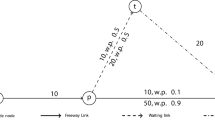Abstract
Road traffic congestion is an increasing problem in urban areas. Building new roads often attracts latent demand and turns parts of the city into building sites for several years. Policy measures that stimulate more effective use of the existing network, such as variable road pricing, are therefore becoming increasingly popular among policy makers and citizens. These measures are often aimed at changing the temporal distribution of traffic. Yet transportation models taking departure time choice into account are rare. This paper describes the implementation of an urban transportation application for Stockholm, which includes departure time choice, mode choice and time dependent network assignment. Through iterations between demand and supply the objective of the transportation model is to forecast effects of congestion charges, intelligent transport systems and infrastructure investments on departure time choice. The complexity of large-scale departure time choice modelling and dynamic traffic assignment is high, which results in very long run times. Therefore, research on how to increase model efficiency is needed. This paper describes choices made in the implementation for a more efficient model.

Similar content being viewed by others
Notes
For more information about the congestion charging system see the homepage of the Swedish Road Administration under “Congestion tax in Stockholm”: http://www.vv.se (2008-11-07).
The reasons for not modelling the whole day are the very long computational run times and that the demand model is estimated on trips not tours, which in its turn is due to the limited scope of the travel behaviour survey conducted at the start of the project.
By “mean travel duration” is here meant the same as the more commonly used term “mean travel time”. Duration is used to clearly distinguish between a point in time and a time span. This distinction is important in discussions related to departure time choice.
The common term is schedule delay early (late), but in this paper deviation will be used instead of delay, since for many traffic engineers delay is defined as extra travel duration in addition to the travel duration under free-flow conditions. Departing earlier than ones preferred departure time results in SDE but not necessarily delay as it is commonly used.
These are pseudo random numbers generated with the command randn in Matlab and transformed from the normal distribution to Johnson′s S B distribution.
References
Algers S, Beser M (2000) SAMPERS—The new Swedish national travel demand forecasting tool. In: IATBR 2000 Conference, Brisbane, July 2000
Bierlaire M (2005) BIOGEME, version 1.4. http://roso.epfl.ch/biogeme
Börjesson M (2006) Issues in urban travel demand modelling: ICt implications-and-trip timing choice. Doctoral thesis, Dept. of Transport and Economics, Royal Institute of Technology, Stockholm. ISBN 10: 91-85539-04-X
Börjesson M (2008) Joint RP-SP data in a mixed logit analysis of trip timing decisions. Transp Res E 44:1025–1038
Cambridge Systematics, Inc., Mark Bradley Research and Consulting, Portland Metro (1998) A system of activity-based models for Portland, Oregon. A demonstration project for the FHWA travel model improvement program (TMIP), Final Report
Daly A, Gunn H, Hungerik G, Kroes E, Mijjer P (1990) Peak-period proportions in large-scale modelling. Presented to the P.T.R.C. summer annual meeting
de Jong G, Daly A, Pieters M, van der Hoorn A (2007) The logsum as an evaluation measure: review of the literature-and-new results. Transportation Research Part A, Policy and Practice, Elsevier
de Palma A, Marchal F (2002) Real cases applications of the fully dynamic METROPOLIS tool-box: an advocacy for large-scale mesoscopic transportation systems. Networks and spatial economics, vol 2(2002). Kluwer Academic, Dordrecht, pp 347–369
de Palma A, Picard N (2005) Route choice decision under uncertainty. Transp Res, A 39:295–324
Dijkstra EW (1959) A note on two problems in connexion with graphs. Numer Math 1:269–271
Eliasson J (2007) The relationship between travel time variability-and-road congestion. Presented at the 2007 world conference of transport research
Gordon A, White C, Oladeinde F, Collins J (2005) Developments in variable demand modelling. Third PTRC transport practitioners’ meeting. http://www.contram.com/tech/papers.shtml
Gordon A, Daly A, Bates J, Oladeinde F (2007) Modelling time period choice in large-scale hierarchical demand models: some problems-and-a solution. Presented to European transport conference, Noordwijkerhout
Kouwenhoven M, Schoemakers A, van Grol R, Kroes E (2005) Development of a tool to assess the reliability of dutch road networks. European transport conference proceedings. Strasbourg, France
Miller S, Daly A, Fox J, Kohli S (2007) Destination sampling in forecasting: application in the PRISM model for the UK west midlands region. Presented to European transport conference, Noordwijkerhout
Noland RB, Lem LL (2002) A review of the evidence for induced travel and changes in transportation and environmental policy in the US and the UK. Transp Res, D 7:1–26
Taylor NB (2003) The CONTRAM traffic assignment model. Kluwer Academic, Dordrecht
Teekamp R, Bezembinder EM, van Amelsfort DH, van Berkum EC (2002) Estimation of preferred departure times-and-changes in departure time patterns. TRB 2002 Annual meeting
UK Department for Transport (2006) Variable demand modelling—convergence realism-and-sensitivity. TAG Unit 3.10.4. http://www.webtag.org.uk/webdocuments/3_Expert/...10_Variable_Demand_Modelling/3.10.4.htm#1_5
van Vuren T, Daly A, Carmichael S, Ben-Akiva M (2002) Modelling peak spreading-and-trip re-timing: hauge consulting group. http://www.dft.gov.uk/stellent/groups/dft_econappr/documents/...divisionhomepage/037554.hcsp
van Vuren T (2005) PRISM—a 21st century transport model for the west midlands region. Final Report, Mott MacDonald. http://www.prism-wm.com/
Vickrey WS (1969) Congestion Theory-and-Transport Investment. Am Econ Rev 59(2):251–260 (Papers and proceedings of the eighty-first annual meeting of the American Economic Association)
Williams IN, Bates J (1993) APRIL—a strategic model for road pricing. In: Proceedings of seminar D. PTRC Summer Annual Meeting, pp 175–187
Acknowledgements
This project is founded by SRA (the Swedish Road Administration) and VINNOVA (the Swedish Governmental Agency for Innovation Systems). We would like to thank Staffan Algers, Andrew Daly, Maria Börjesson, Jonas Eliasson and Fredrik Davidsson for their advice and fruitful discussions.
Author information
Authors and Affiliations
Corresponding author
Rights and permissions
About this article
Cite this article
Kristoffersson, I., Engelson, L. A Dynamic Transportation Model for the Stockholm Area: Implementation Issues Regarding Departure Time Choice and OD-pair Reduction. Netw Spat Econ 9, 551–573 (2009). https://doi.org/10.1007/s11067-009-9104-0
Published:
Issue Date:
DOI: https://doi.org/10.1007/s11067-009-9104-0







